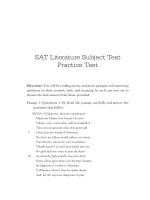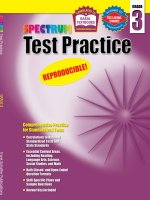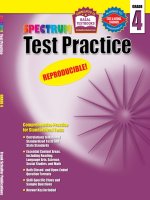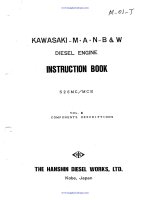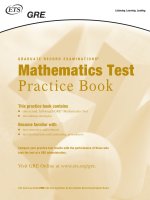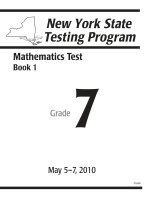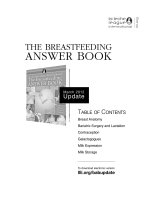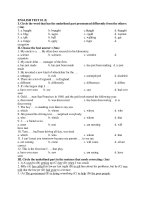GRADUATE RECORD EXAMINATIONS® Mathematics Test Practice Book pptx
Bạn đang xem bản rút gọn của tài liệu. Xem và tải ngay bản đầy đủ của tài liệu tại đây (3.14 MB, 64 trang )
GRADUATE RECORD EXAMINATIONS
®
Mathematics Test
Practice Book
This practice book contains
Ⅲ one actual, full-length GRE
®
Mathematics Test
Ⅲ test-taking strategies
Become familiar with
Ⅲ test structure and content
Ⅲ test instructions and answering procedures
Compare your practice test results with the performance of those who
took the test at a GRE administration.
Visit GRE Online at www.ets.org/gre.
This book is provided FREE with test registration by the Graduate Record Examinations Board.
Copyright © 2007 by Educational Testing Service. All rights reserved. ETS, the ETS logos,
GRADUATE RECORD EXAMINATIONS, and GRE are registered trademarks of Educational Testing Service (ETS)
in the United States of America and other countries throughout the world.
LISTENING. LEARNING. LEADING. is a trademark of ETS.
Note to Test Takers: Keep this practice book until you receive your score report.
This book contains important information about content specifi cations and scoring.
®
3
MATHEMATICS TEST
PRACTICE BOOK
Purpose of the
GRE Subject Tests
The GRE Subject Tests are designed to help graduate
school admission committees and fellowship sponsors
assess the qualifi cations of applicants in specifi c fi elds
of study. The tests also provide you with an assessment
of your own qualifi cations.
Scores on the tests are intended to indicate
knowledge of the subject matter emphasized in many
undergraduate programs as preparation for graduate
study. Because past achievement is usually a good
indicator of future performance, the scores are helpful
in predicting success in graduate study. Because
the tests are standardized, the test scores permit
comparison of students from different institutions with
different undergraduate programs. For some Subject
Tests, subscores are provided in addition to the total
score; these subscores indicate the strengths and
weaknesses of your preparation, and they may help you
plan future studies.
The GRE Board recommends that scores on the
Subject Tests be considered in conjunction with other
relevant information about applicants. Because numer-
ous factors infl uence success in graduate school,
reliance on a single measure to predict success is not
advisable. Other indicators of competence typically
include undergraduate transcripts showing courses
taken and grades earned, letters of recommendation,
and GRE General Test scores. For information about
the appropriate use of GRE scores, write to GRE
Program, Educational Testing Service, Mail Stop 57-L,
Princeton, NJ 08541, or visit our website at www.ets.
org/gre/stupubs.html.
Development of the
Subject Tests
Each new edition of a Subject Test is developed by
a committee of examiners composed of professors in
the subject who are on undergraduate and graduate
faculties in different types of institutions and in
different regions of the United States and Canada.
In selecting members for each committee, the
GRE Program seeks the advice of the appropriate
professional associations in the subject.
The content and scope of each test are specifi ed
and reviewed periodically by the committee of exam-
iners. Test questions are written by the committee and
by other faculty who are also subject-matter specialists
and by subject-matter specialists at ETS. All questions
proposed for the test are reviewed by the committee
and revised as necessary. The accepted questions are
assembled into a test in accordance with the content
specifi cations developed by the committee to ensure
adequate coverage of the various aspects of the fi eld
and, at the same time, to prevent overemphasis on any
single topic. The entire test is then reviewed and
approved by the committee.
Table of Contents
Purpose of the GRE Subject Tests 3
Development of the Subject Tests 3
Content of the Mathematics Test 4
Preparing for a Subject Test 5
Test-Taking Strategies 5
What Your Scores Mean 6
Practice Mathematics Test 9
Scoring Your Subject Test 55
Evaluating Your Performance 58
Answer Sheet 59
4
MATHEMATICS TEST
PRACTICE BOOK
Subject-matter and measurement specialists on the
ETS staff assist the committee, providing information
and advice about methods of test construction and
helping to prepare the questions and assemble the test.
In addition, each test question is reviewed to eliminate
language, symbols, or content considered potentially
offensive, inappropriate for major subgroups of the test-
taking population, or likely to perpetuate any negative
attitude that may be conveyed to these subgroups. The
test as a whole is also reviewed to ensure that the test
questions, where applicable, include an appropriate
balance of people in different groups and different roles.
Because of the diversity of undergraduate curricula,
it is not possible for a single test to cover all the
material you may have studied. The examiners,
therefore, select questions that test the basic
knowledge and skills most important for successful
graduate study in the particular fi eld. The committee
keeps the test up-to-date by regularly developing new
editions and revising existing editions. In this way,
the test content changes steadily but gradually, much
like most curricula. In addition, curriculum surveys
are conducted periodically to ensure that the content
of a test refl ects what is currently being taught in the
undergraduate curriculum.
After a new edition of a Subject Test is fi rst
administered, examinees’ responses to each test
question are analyzed in a variety of ways to determine
whether each question functioned as expected. These
analyses may reveal that a question is ambiguous,
requires knowledge beyond the scope of the test, or
is inappropriate for the total group or a particular
subgroup of examinees taking the test. Answers to such
questions are not used in computing scores.
Following this analysis, the new test edition is
equated to an existing test edition. In the equating
process, statistical methods are used to assess the
diffi culty of the new test. Then scores are adjusted
so that examinees who took a diffi cult edition of the
test are not penalized, and examinees who took an
easier edition of the test do not have an advantage.
Variations in the number of questions in the different
editions of the test are also taken into account in this
process.
Scores on the Subject Tests are reported as three-
digit scaled scores with the third digit always zero.
The maximum possible range for all Subject Test total
scores is from 200 to 990. The actual range of scores for
a particular Subject Test, however, may be smaller. The
maximum possible range of Subject Test subscores is
20 to 99; however, the actual range of subscores for
any test or test edition may be smaller. Subject
Test score interpretive information is provided in
Interpreting Your GRE Scores, which you will receive
with your GRE score report, and on the GRE website
at www.ets.org/gre/stupubs.html.
Content of the
Mathematics Test
The test consists of 66 multiple-choice questions,
drawn from courses commonly offered at the
undergraduate level. Approximately 50 percent of
the questions involve calculus and its applications
—subject matter that can be assumed to be common
to the backgrounds of almost all mathematics majors.
About 25 percent of the questions in the test are in
elementary algebra, linear algebra, abstract algebra,
and number theory. The remaining questions deal
with other areas of mathematics currently studied by
undergraduates in many institutions.
The following content descriptions may assist
students in preparing for the test. The percentages
given are estimates; actual percentages will vary
somewhat from one edition of the test to another.
Calculus
— 50%
Material learned in the usual sequence of elementary
calculus courses
— differential and integral calculus
of one and of several variables
— including calculus-
based applications and connections with coordinate
geometry, trigonometry, differential equations, and
other branches of mathematics
Algebra
— 25%
Elementary algebra: basic algebraic techniques and
manipulations acquired in high school and used
throughout mathematics
5
MATHEMATICS TEST
PRACTICE BOOK
Linear algebra: matrix algebra, systems of linear
equations, vector spaces, linear transformations,
characteristic polynomials, eigenvalues and
eigenvectors
Abstract algebra and number theory: elementary
topics from group theory, the theory of rings and
modules, fi eld theory, and number theory
Additional Topics
— 25%
Introductory real analysis: sequences and series of
numbers and functions, continuity, differentiability
and integrability, elementary topology of ޒ and ޒ
n
Discrete mathematics: logic, set theory, combina-
torics, graph theory, and algorithms
Other topics: general topology, geometry, complex
variables, probability and statistics, and numerical
analysis
The above descriptions of topics covered in the test
should not be considered exhaustive; it is necessary to
understand many other related concepts. Prospective
test takers should be aware that questions requiring
no more than a good precalculus background may be
quite challenging; some of these questions turn out to
be among the most diffi cult questions on the test. In
general, the questions are intended not only to test
recall of information, but also to assess the test taker’s
understanding of fundamental concepts and the ability
to apply these concepts in various situations.
Preparing for a Subject Test
GRE Subject Test questions are designed to measure
skills and knowledge gained over a long period of time.
Although you might increase your scores to some extent
through preparation a few weeks or months before you
take the test, last minute cramming is unlikely to be of
further help. The following information may be helpful.
Ⅲ A general review of your college courses is
probably the best preparation for the test.
However, the test covers a broad range of subject
matter, and no one is expected to be familiar
with the content of every question.
Ⅲ Use this practice book to become familiar with
the types of questions in the GRE Mathematics
Test, paying special attention to the directions. If
you thoroughly understand the directions before
you take the test, you will have more time during
the test to focus on the questions themselves.
Test-Taking Strategies
The questions in the practice test in this book
illustrate the types of multiple-choice questions in
the test. When you take the test, you will mark your
answers on a separate machine-scorable answer sheet.
Total testing time is two hours and fi fty minutes; there
are no separately timed sections. Following are some
general test-taking strategies you may want to consider.
Ⅲ Read the test directions carefully, and work as
rapidly as you can without being careless. For
each question, choose the best answer from the
available options.
Ⅲ All questions are of equal value; do not waste
time pondering individual questions you fi nd
extremely diffi cult or unfamiliar.
Ⅲ You may want to work through the test quite
rapidly, fi rst answering only the questions about
which you feel confi dent, then going back and
answering questions that require more thought,
and concluding with the most diffi cult questions
if there is time.
Ⅲ If you decide to change an answer, make sure
you completely erase it and fi ll in the oval
corresponding to your desired answer.
Ⅲ Questions for which you mark no answer or more
than one answer are not counted in scoring.
Ⅲ As a correction for haphazard guessing, one-
fourth of the number of questions you answer
incorrectly is subtracted from the number of
questions you answer correctly. It is improbable
that mere guessing will improve your score
signifi cantly; it may even lower your score. If,
however, you are not certain of the correct
answer but have some knowledge of the question
and are able to eliminate one or more of the
answer choices, your chance of getting the
right answer is improved, and it may be to your
advantage to answer the question.
Ⅲ Record all answers on your answer sheet.
Answers recorded in your test book will not
be counted.
Ⅲ Do not wait until the last fi ve minutes of a testing
session to record answers on your answer sheet.
6
MATHEMATICS TEST
PRACTICE BOOK
Range of Raw Scores* Needed
to Earn Selected Scaled Scores on
Three Mathematics Test
Editions That Differ in Diffi culty
Raw Scores
Scaled Score Form A Form B Form C
900 66 62 60
– 61
800 55 51 49
700 43 40 38
600 30 29 28
Number of Questions Used to Compute Raw Score
66 66 65
*Raw Score = Number of correct answers minus one-fourth the
number of incorrect answers, rounded to the nearest integer.
For a particular test edition, there are many ways to
earn the same raw score. For example, on the edition
listed above as “Form A,” a raw score of 30 would earn
a scaled score of 600. Below are a few of the possible
ways in which a scaled score of 600 could be earned on
that edition.
Examples of Ways to Earn
a Scaled Score of 600 on the
Edition Labeled As “Form A”
Number of
Questions
Questions Questions Questions Used to
Raw Answered Answered Not Compute
Score Correctly Incorrectly Answered Raw Score
30 30 0 36 66
30 33 14 19 66
30 37 27 2 66
What Your Scores Mean
Your raw score — that is, the number of questions you
answered correctly minus one-fourth of the number
you answered incorrectly
— is converted to the scaled
score that is reported. This conversion ensures that
a scaled score reported for any edition of a Subject
Test is comparable to the same scaled score earned
on any other edition of the same test. Thus, equal
scaled scores on a particular Subject Test indicate
essentially equal levels of performance regardless of
the test edition taken. Test scores should be compared
only with other scores on the same Subject Test. (For
example, a 680 on the Computer Science Test is not
equivalent to a 680 on the Mathematics Test.)
Before taking the test, you may fi nd it useful
to know approximately what raw scores would be
required to obtain a certain scaled score. Several
factors infl uence the conversion of your raw score
to your scaled score, such as the diffi culty of the test
edition and the number of test questions included in
the computation of your raw score. Based on recent
editions of the Mathematics Test, the following table
gives the range of raw scores associated with selected
scaled scores for three different test editions that have
been rescaled. (Note that when the number of scored
questions for a given test is greater than the range of
possible scaled scores, it is likely that two or more raw
scores will convert to the same scaled score.) The
three test editions in the table that follows were
selected to refl ect varying degrees of diffi culty.
Examinees should note that future test editions may be
somewhat more or less diffi cult than the test editions
illustrated in the table.
7
MATHEMATICS TEST
PRACTICE BOOK
PRACTICE TEST
To become familiar with how the administration will be conducted at the test center, fi rst remove the
answer sheet (pages 59 and 60). Then go to the back cover of the test book (page 54) and follow the
instructions for completing the identifi cation areas of the answer sheet. When you are ready to begin the
test, note the time and begin marking your answers on the answer sheet.
9
10
MATHEMATICS TEST
Time—170 minutes
66 Questions
Directions: Each of the questions or incomplete statements below is followed by five suggested answers or
completions. In each case, select the one that is the best of the choices offered and then mark the corresponding
space on the answer sheet.
Computation and scratchwork may be done in this examination book.
Note: In this examination:
(1) All logarithms with an unspecified base are natural logarithms (that is, with base e).
(2) The set of all real numbers x such that a ≤ x ≤ b is denoted by [a, b].
(3) The symbols ޚ, ޑ, ޒ, and ރ denote the sets of integers, rational numbers, real numbers, and
complex numbers, respectively.
11
SCRATCHWORK
12
13
SCRATCHWORK
14
15
SCRATCHWORK
16
17
SCRATCHWORK

